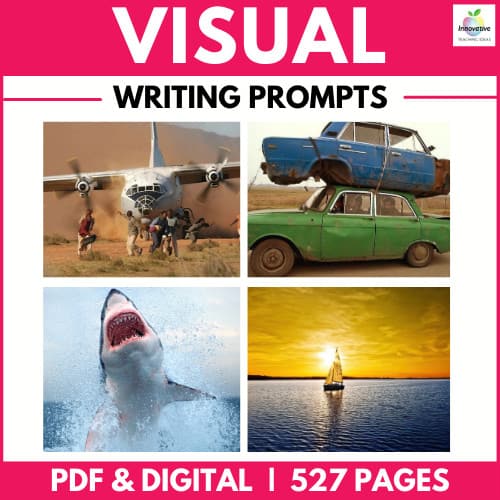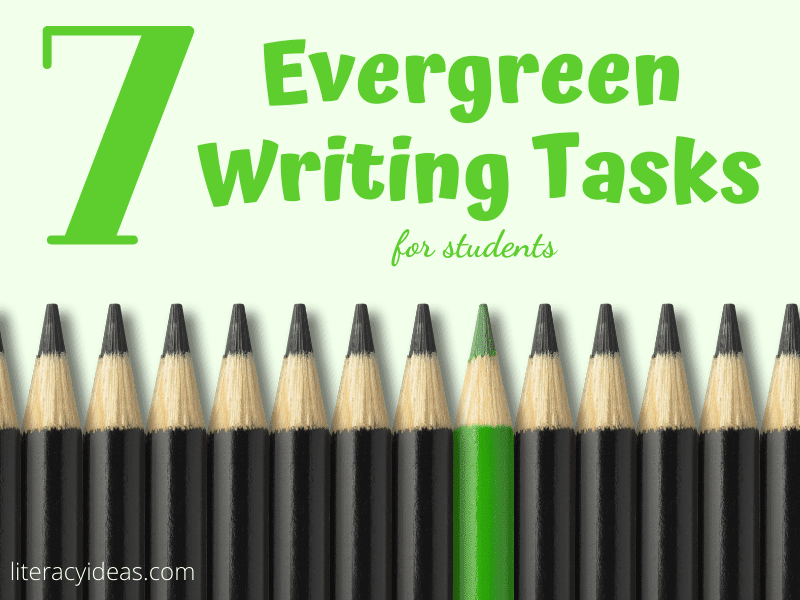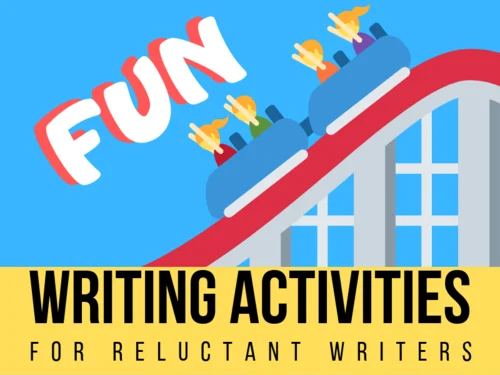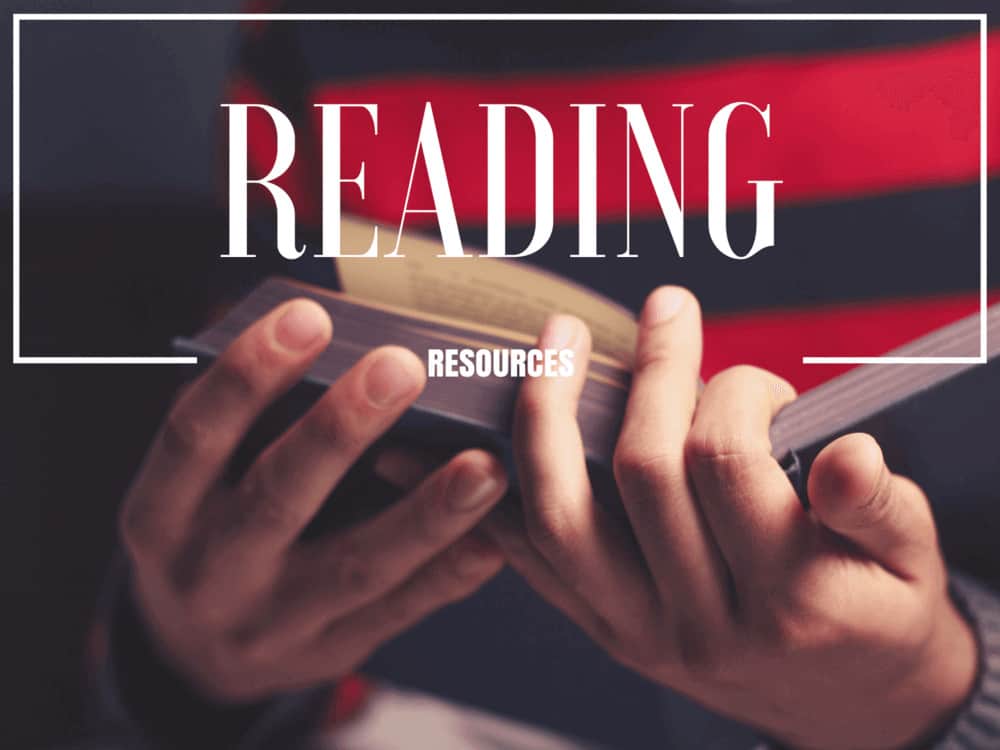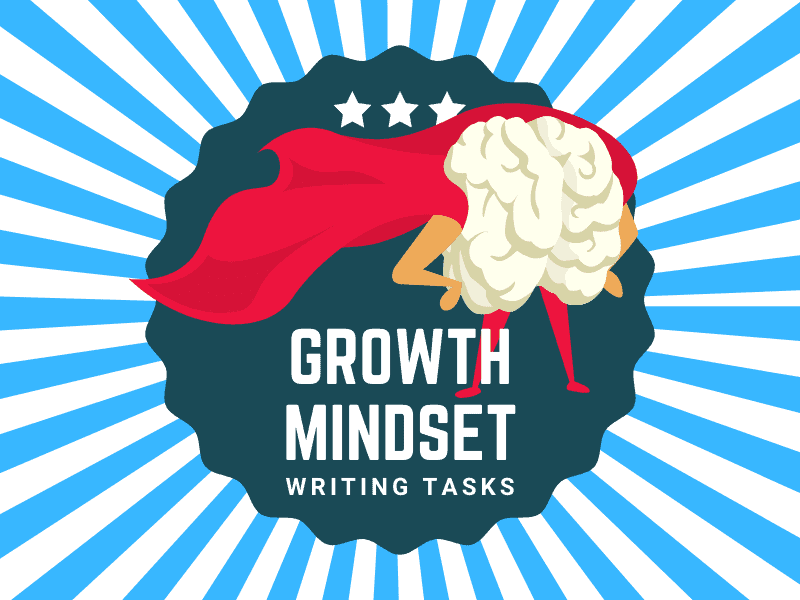
The smell of freshly painted halls, the excited chatter of returning students bursting with two months’ worth of gossip to share—it must be the first day at school again.
Rusty pens and dusty pencils are hastily pulled from the bottom of school bags where, for many, they’ve lain all summer, ready for back to school.
You’ll need engaging writing activities to get those atrophied writing muscles back in shape. The standard ‘What I Did This Summer’ essay won’t cut it.
Luckily, we have 17 Great Back-to-School Writing Activities for you to help shake off the cobwebs and get your students’ writing skills back on par. Let’s get started.
Ice Breaker
Writing Activities
At the start of each school year, there’s likely to be a new face or two in the class, and while two months isn’t a long time in the grand scheme of things, our students can do a lot of growing and changing in that time.
Ice-breaker writing activities allow students to connect with others in the class. They give students some insight into the lives of their classmates.
Here are some fun ice-breaker writing activities to get the new school year off to a strong start writing-wise.

The A to Z of Me! Poem
Students write an acrostic poem about themselves in the A to Z of Me. The poem’s first line starts with the letter A, and each new line begins with the following letter of the alphabet, which should reveal something about the poet.
This may be too long for younger students – it’d be a 26-line poem after all. In this case, you can quickly adapt the activity to employ the letters of the student’s first name.
This activity aims for students to capture the essence of who they are in their poems. They can write a phrase or line based on their interests, appearance, things they have done, hobbies, desires, ideas, where they’re from, etc.
You can make this more challenging for older and stronger students by insisting they employ a rhyme scheme throughout their poems.
For example, they could write their poem in couplets (AA, BB, CC, etc.) or with an alternate line rhyming scheme (AB, AB, AB, etc).
When students have finished writing their acrostic poems about themselves, they can perform it to the whole class as a class poetry slam.
Guess Who? Writing Task
This fun activity challenges students to recall what they know about their classmates or, in the case of a newly formed group of students, to explore their initial impressions of each other.
In Guess Who?, the teacher divides the students into two groups. Each group writes down a unique fact about themselves on a piece of paper, folds it, and gives it to the teacher.
If everyone already knows each other very well, you might want to limit the facts to something they did over the summer that the others in the class are unaware of.
Students could write about a hobby or talent, a language they speak, a place they visited, or anything that makes them unique or special.
Students then take turns reading a fact written by someone from the other group, and they then guess who wrote it.
A point is awarded for each correct guess, the winning team being the team with the most points.


Interview A Classmate Writing Activity:
This activity allows students to get to know each other better while developing their interviewing, note-taking, and writing skills.
Begin this activity by asking the students to compile a list of questions that they would use to get to know someone they’d met for the first time.
The first questions the students generally tend to be surface-level small-talk-type questions such as:
- Where are you from?
- How many brothers and sisters do you have?
- What’s your favourite subject at school?
- What are your hobbies?
- What do you want to be when you grow up?
- What’s the best thing about you?
Write these on the whiteboard, of course. They’ll be helpful to as warm-up openers at the beginning of the interviews, but we want to encourage a deeper dive.
For the interviewer to better understand the interviewee, they’ll need to probe further.
Encourage students to come up with more challenging questions to ask in the interview and write these on the board. These questions should be geared toward gaining insight beyond the superficial.
Explain to the students that when they are the interviewee, if they’d prefer not to answer a specific question, they can just say “next” and the interviewer will move immediately onto the next question.
Some examples of deeper, more probing-type questions might include questions like:
- Can you tell me about an event or a story that significantly impacted your life?
- Who has had the most significant influence on who you are?
- What is the most challenging thing you’ve ever had to do?
- What is your best memory? Worst?
At the end of this brainstorming session, a considerable list of questions should be on the whiteboard.
Students are then partnered up. They will then take turns interviewing each other, with each interviewer taking comprehensive notes as they interview.
Students should not use voice recording equipment during this activity. This activity aims to improve note-taking abilities.
When the interviews are over, students write them up as best they can, using their notes and memories to recreate them.
For the more advanced students, this will involve recreating the interview’s dialogue and weaving a narrative around it to convey the interviewee’s character, expressions, and mannerisms.
First Day of School Persuasive Wish List Task
The start of a new school year is a time of hope and possibility captured in the form of a wish list.
But this isn’t an old wish list but a persuasive one.
The students will write a wish list of things they hope for from the new school year.
The twist is that they must make their case for why they should receive the concessions they seek.
Some items that might make the wish list could be the desire to see more time for their favourite activities, less homework, or creating a class council. It doesn’t matter what is on the list but that the student makes as strong a case as possible for them.
Students should be encouraged to use the full range of persuasive writing techniques available, from emotional language to social proof, from repetition to evidence and statistics.
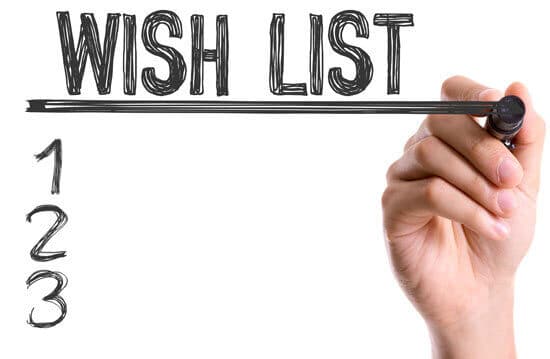
Collaborative Writing Activities
Collaborative writing activities offer students opportunities to work with a partner, a small group, or the whole class to produce a shared piece of writing.
As with the previous activities, these activities can break the ice. More than that, they help students establish a level of comfort working together to achieve a shared goal – a key dynamic to encourage at the start of any school year.

Snowball Story-Writing
In this simple but fun activity, each student starts by writing the beginning of a story. There should be an allotted amount of time to complete this, the length of which will depend on the age and abilities of the students.
When the allotted time is up, students should stop writing, roll their paper into a ball, and throw it towards the top of the classroom!
Students should then each retrieve one of the ‘snowballs’ from the front of the classroom and, when the timer is started, read the beginning of the story and then write the story middle until the time is up.
Again, the students throw their snowballs to the front of the classroom, before selecting a new snowball to write the ending.
When the stories are completed, they should be returned to the students who wrote the story beginning. This student should write a final draft of the story to ensure it reads well
Students can then share their stories by reading them out to the class.
Sometimes, students struggle to start their writing. To help them get going, it can be helpful to provide them with a sheet of paper with a writing prompt. This prompt can be a sentence or even a picture.
These prompts can be easily differentiated to suit the age and abilities of your students. For example, more prescriptive prompts are helpful for younger students, while more open-ended prompts will suit older and/or stronger students.
Tapestry Poems
Tapestry poems are a collaboration between two students. So, as a first step, you need to assign each student a partner to work with.
The next step requires you to assign a topic for each pair of students in the class. Each partner then independently writes a 9-line poem on the assigned topic.
When each student has finished their 9-line poem, they share them with their partner.
The task is for the students to work together now to produce an 18-line poem from the two 9-line poems they have created.
To do this, the students must collaborate to make the composite poem work. The idea here is to weave the different threads of the two topic interpretations into a single ‘tapestry’.
Students must include the nine lines of both poems, but they have room to edit for verb tense and make minor grammatical changes to make things work.
The partners must also compromise to agree on a single title for their shared piece.


The Peer Editing Exercise
This is a great way to introduce peer assessment into your classroom, especially with a group of students who are not familiar with the concept.
You will need to explain the editing and proofreading process to the students at the start. The specific criteria will, of course, depend on the age and abilities of your students.
To begin, organize the class into pairs of editing partners. Students should then swap their written work to be edited by their partners.
Any of the previous writing activities in this article would serve this purpose well.
Students can edit their partner’s work by annotating with a different colour pen, or, for more detailed commentary, they could use a separate sheet of paper.
Students then share their feedback.
This is an opportunity for students to see each other as resources to help them on their learning journey throughout the year.
It also helps students to develop resilience and an ability to absorb constructive criticism.
Students then rewrite their text in light of the feedback given.
Time for a plenary session should be made at the end to discuss their experiences of the process as a class.
The Summer Yearbook Writing Task
This writing project is based on the idea of school yearbooks.
School yearbooks are compilations of memories, photographs, and quotes. In this version, students compile a compendium based on their collective experiences during the school break.
The format can inspire many writing activities.
Students can gather quotes on the various events of vacation time together. These can be sourced from family, friends, classmates, etc.
They can also collect photographs and write suitable captions for inclusion in the yearbook. The book could include a page for the students’ autographs and a page for summer memories and hopes for the coming year.
Technology can be easily incorporated into this lesson by producing a digital version. Collaborative applications such as Google Drive are perfect for this type of work.

Year Long Inference Based Writing Activities
Tap into the power of imagery in your classroom to master INFERENCE as AUTHORS and CRITICAL THINKERS.
⭐⭐⭐⭐⭐ (26 Reviews)
This YEAR-LONG 500+ PAGE unit is packed with robust opportunities for your students to develop the critical skill of inference through fun imagery, powerful thinking tools, and graphic organizers.
Memory Writing Activities
While we want to avoid the cliched ‘What I Did This Summer’ essay, it doesn’t mean that memories of the long holidays can’t serve as an ‘in’ to some worthwhile writing activities.
In the following writing activities, students will be asked to access their memories of summer to serve as a jumping-off point. Let’s get started!

Paint a Picture With Words
Essentially, this writing activity challenges students to write by employing their senses to evoke a memory.
First, ask the students to choose from a memory of a place they visited during the summer vacation. It doesn’t matter whether it’s a beach trip or a visit to a shopping mall; they’ll both serve equally well for this activity.
Students must then endeavour to recreate the scene as they recall it through careful selection of vocabulary and description.
The main focus of this type of writing will be the use of sensory language. Students should meditate on what they saw, heard, smelled, tasted, and felt while in their chosen place.
Students should work to paint a vivid, multi-dimensional picture in the reader’s minds-eye. For this reason, they should choose a static memory, such as a scene they recall. This activity has more in common with landscape painting than with film-making. A plot is not required.
This activity allows students to hone their descriptive writing skills, which will help them improve their writing in many genres.
Haiku Writing Activity
As with the last activity, this type of poetry is typically focused on evoking a scene. In the case of the haiku, this is usually a natural scene.
Before putting pen to paper, be sure students are suitably familiar with the features of the haiku:
- It consists of 3 lines
- It contains 17 syllables
- The 1st and 3rd lines have 5 syllables and the 2nd line has 7 syllables
- It does not need to rhyme
- It’s usually about nature or a natural phenomenon
- Often has two contrasting or juxtaposed subjects woven into it.
This activity is best introduced by reading and examining a couple of well-written haikus, such as those by Basho in translation, to ensure student familiarity with the form.
This is a very meditative writing form. It is essential to set a suitable mood and atmosphere in the classroom to encourage the necessary concentration and reflection the writing process will require. Playing gentle instrumental music is one way to help achieve this ambience.

Fun Back To School Writing Activities
While the first of our Back to School Writing Activities focuses clearly on breaking the ice and drawing on memories, the primary focus of the following writing activities is on having fun.
These activities will also offer students opportunities to develop some technical aspects of their writing skills; the main emphasis here is on students seeing writing as a fun, creative activity where they have the space and time for self-expression.
Don’t forget to read our complete guide to Fun Writing activities here.

Creative Excuses Writing Task
To start this activity, students must devise a list of 10 chores or tasks they absolutely hate doing.
Next, students should choose four from this list of their most detested tasks and write a letter explaining why they cannot complete them.
Encourage students to get creative with their excuses. The crazier and more imaginative the excuses are, the better. This activity is an opportunity for students to let their imaginations loose.
‘What If?’ Writing Prompts
Writing prompts are an excellent way for students to break through writer’s block. In this activity, students generate their own writing prompts by creating ‘what if?’ scenarios for other students in the class to use as writing prompts.
Many of the best and most creative stories start with an inquiry into what would happen if x happened. These scenarios can be silly, serious, fantastical, or humorous if they provide a jumping-off point for the student writer.
When students have completed their prompts, the teacher should gather them to distribute randomly among the class.
Students can share their work with the class When they have finished writing their responses to their assigned prompts. This will be especially interesting for the writer of the original prompt.


The Book Of Summer
This writing activity is an upgrade from the “My Summer Vacation” type essays.
In this activity, each student will compile their Book of Summer, describing and depicting their holidays using as many different writing genres as possible.
For example, the student might include the following in their Book of Summer:
- A non-chronological report on a day trip
- A comic strip based on a family celebration
- A review of a movie they saw or book they read
- A fictionalized account of their summer
- A recipe of a meal they made
- A playscript for a sleepover they went on
- A haiku on the end of summer
The scope for creative interpretations here is almost endless.
For younger students, it may be best to be more prescriptive about the various genres to include and the titles for each piece.
But for students with the ability, the open-endedness of this task allows their creativity to run loose while affording you a valuable opportunity to see just what they are capable of.
Be sure to read our complete collection of back-to-school writing activities.
Fictional Interviews Writing Task
This activity involves a little bit of writing and a lot of role-playing.
In this activity, students should be paired up with a partner. Each partner chooses a fictional character they will role-play. The character can be from any fiction, for example, movies, comic books, or literature.
Partners must prepare and write up a series of interview questions for their partner’s fictional character.
Partners take turns interviewing each other while the interviewee is in character.
This is a great way to bring a bit of drama into the classroom, but if you want to emphasize the writing aspect of the activity, you can set the students up for the interview in the style of a magazine feature article. This will require the student to weave some narrative writing around the back and forth of the questions and answers of the interview.


Write A Story From A Different Point Of View
Narrative writing requires competency in a broad range of complex skills. We can roughly divide those skills into structural ones (such as text organization) and language-related skills (such as sentence construction and creativity).
Getting your students to write a story is a great way to assess their abilities in these areas.
In this activity, however, you provide most of the structure for the student, giving them the space to exercise their imagination and a chance to focus on their grammatical control – among other things.
In this exercise, ask your students to select a favourite fairy tale or other traditional story they know well. The student’s task is to rewrite their favourite fairy tale from the point of view of another important character in the story.
For example, they might want to retell the Jack and the Beanstalk story from the point of view of the Giant or Jack’s mother.
Retelling The Ugly Duckling, the student might want to write from Mother Duck’s perspective to explore her feelings about the runt of her litter suddenly transforming into a beautiful (if alien!) swan
Summer Headlines Writing Activity
Headlines are fun to write.
They should be short and pithy, seizing the reader’s attention by telling them just enough about the story to pique their interest but still leave them wanting to read more.
There are several things that students can do to ensure their headlines have the desired effect, including:
- Choose powerful words designed to make an impact
- Use alliteration to create catchy, snappy headlines
- Employ humour to entertain and intrigue the reader
- Create suspense by posing the headline as a question
For this activity, students should list the main events of their summer break and create a headline for each event.
In this way, the students will have produced an account of their summer written entirely in headlines.
As an extension to this exercise, when they’ve finished producing their headlines, have them present them to the class or in smaller groups.
The best headline is selected from each list, which the student has to turn into a complete newspaper-style article on that event.


Rap and Verse Writing Task
Few genres of writing can be as divisive.
Some are dismayed by the mere mention of the word ‘poetry’ – The “Why can’t poets just say what they mean?” camp.
Then, some can barely write a shopping list without a bit of unnecessary versifying.
Love it or loathe it, poetry is on the curriculum and our students need to get to grips with it.
For this activity, students write a series of poems inspired by the events of their summer holidays. Essentially, they are writing a poetic account of their vacation.
To challenge the students, they must use a different type of poetry for each event they wish to retell.
For example, they might write a series of haikus on the weather during the summer break.
Perhaps they’ll produce a calligram or shape poem describing the treehouse they made.
Maybe they’ll write an elegy to a pet that died or a limerick on that disastrous camping trip.
They might like to use the headlines from the previous activity A Summer in Headlines as starting points for their poems.
By the end of this activity, your students will have a collection of self-authored poetry they can share with the class in the form of a poetry slam.
You may wish to provide your students with checklists of the various features of the different types of poetry to help them during this activity.
So, there we have seventeen engaging activities to kick start the writing process at the start of the school year.
There is quite a variety from here, with some activities honing technical aspects of the writing process while others are more centred on the fun of creativity.
Remember, at the start of the school year, what the students write isn’t so important, but what they write!
With the selection of activities above, you’re sure to find one to suit even the most pen-shy students!


